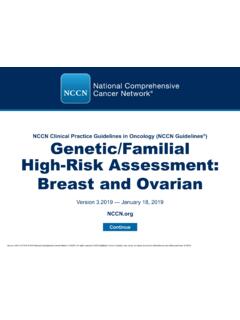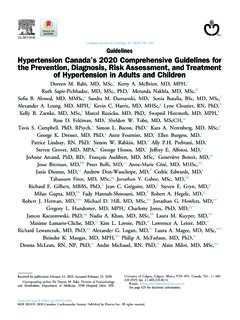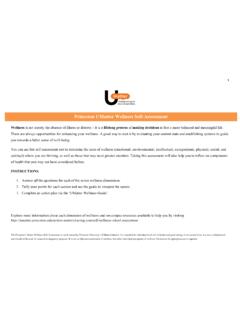Transcription of CARDIOVASCULAR RISK ASSESSMENT QUESTIONNAIRE
1 CARDIOVASCULAR RISKASSESSMENT QUESTIONNAIRENameDateCardiovascular Disease: The Number One KillerCardiovascular disease is the biggest cause of death in Australia and New Zealand, with one person dying from it every ten minutes. That s over 50,000 people per year dying from heart attacks, strokes and blood is CARDIOVASCULAR Disease? CARDIOVASCULAR disease is the accumulation of fat in the arteries. This fat can cause blood clots to form and if large enough can completely block a blood vessel. When a clot blocks a blood vessel that is feeding the heart, part of the heart will die.
2 This is called a heart attack. If a clot blocks a blood vessel connected to the brain, part of the brain will die, and this is called a Causes CARDIOVASCULAR Disease?Most people know that high cholesterol and blood pressure contribute to your risk of a heart attack. Knowing your cholesterol level and blood pressure is an important step in reducing your risk. However, 50% of people who have heart attacks don t have high cholesterol or high blood pressure. There are other important factors that can increase your risk of CARDIOVASCULAR may have risk factors which haven t been measured by your doctor.
3 For example, you may be under stress, not doing enough exercise, have poor immune function or be eating too much sugar. These are just a few of the many factors that may cause CARDIOVASCULAR Do I Reduce My Risk of CARDIOVASCULAR Disease?To reduce your risk of CARDIOVASCULAR disease you need to know what may be putting you in danger and what you can do about it. This QUESTIONNAIRE will help identify your risk of CARDIOVASCULAR disease and allow you and your Healthcare Practitioner to decide on the most appropriate dietary changes, lifestyle changes or supplements to help you maintain a healthy heart and blood Do I Complete This QUESTIONNAIRE ?
4 There are two parts to this QUESTIONNAIRE . Part 1 is for you, the patient, to fill in. Part 2 is for your Practitioner to complete. This QUESTIONNAIRE may be completed with or without blood test results, however, having the test results is preferable as it will give a more accurate ASSESSMENT of your risk. If possible please obtain the following tests from your doctor:Part 1 - For the Patient: You must answer every question. Each answer to a question has a numbered score in the right-hand column.
5 Read the instructions of every question carefully. For some questions you need to circle only one score, while for others you will need to circle all the scores that apply to you. If you don t know the answer to a question, circle Don t know . At the end of each numbered section, add the scores for that section in the Total area provided (shaded). Your Practitioner will complete your ASSESSMENT by filling out Part 2 for 2 - For the Practitioner: Fill out Part 2 using your patient s pathology results, or the alternatives offered at each question.
6 Write the total scores from each category of Part 1 and Part 2 on the Score Sheet (page 11). Based on the total for each category, tick the appropriate priority box. Add the total column for each category to achieve a total CARDIOVASCULAR Score. Classify your patients total CARDIOVASCULAR Risk based on this CholesterolLDL CholesterolTriglyceridesApo B / Apo A1 ratioLipoprotein (a)C-reactive protein (hs-CRP)HomocysteineFibrinogenFasting glucose / Glucose tolerance test / HbA1cBlood Pressure2 PART 1: Patient QUESTIONNAIRE Patient to completeAgeLifestyleFamily HisoryCardiovascular HistoryUnder 30030 34135 39640 441545 494050 547055 5910060 6411065 6912070 7413075 and over140 Add Age Total.
7 Sedentary moderate exercise less thanonce a week20 Moderate exercise (average once per week)1 Moderate exercise (average 2 3 times per week)-10 Moderate exercise (average 4 5 times per week)-20 Moderate exercise(average 5 or more times per week)-25 Never smoked0Ex-smoker10 Current smoker less than 20 cigarettes/day50 Current smoker more than 20 cigarettes/day80 Average 0 drinks daily0 Average 1 drink daily or 7 units per week-10 Average 2 drinks daily or 14 units per week-5 Average 3 or more drinks daily or 21 or more units per week5Do you consume:Male: 5 or more drinksFemale: 3 or more drinksin one sitting on a fortnightly or more frequent basis?
8 7 Yes25No0 Mother with CARDIOVASCULAR Disease at less than65 years (high blood pressure, heart attack,angina, stroke, hardening of the arteries)15 Father with CARDIOVASCULAR Disease at less than55 years (high blood pressure, heart attack,angina, stroke, hardening of the arteries)15 Parent with Type II Diabetes (adult-onset diabetes)15 Add Family History Total:Do you live on a main road?4Do you live in a city?3Do you live in an industrial area with gasemissions?2Do you work with any chemicals, cleaners,pesticides, petrochemicals, paints, exhausts?
9 4 Add Lifestyle Total (section a to f):Do you have diagnosed CARDIOVASCULAR disease,atherosclerosis, previous heart attack, and/orprevious stroke100 Have you experienced angina (heart pain)within the last 3 months150 Add CARDIOVASCULAR History Total:Section (a) How old are you? (circle one score)Section (a) Exercise (circle one score)Section (b) Smoking (circle one score)Section (d) Alcohol (circle score if applicable)Section (e) Alcohol (circle score if applicable)Section (c) Passive smoking (a non-smoker exposed to smoke most days at home or work) (circle one score)Moderate exercise is brisk walking, jogging, cycling, swimming, playing sports or any exercise that increases breathing and heart rate continuously for at least 20 (a)
10 (circle score if applicable)Section (f) Environment (circle score if applicable)Section (a) (circle score if applicable)3 PART 1: Patient QUESTIONNAIRE Patient to completeStressSleep0 465 637 80 More than 8 hours4 Snoring3 Obstructive sleep apnoea10 Insomnia, difficulty falling asleep or interruptedsleep3 Add Sleep Total (section a to b):Do you feel anxiety, worry, fear, sudden feelings ofpanic, inability to control breathing and acceleratedheart rate when upset, or recurrent feelings ofunease?






